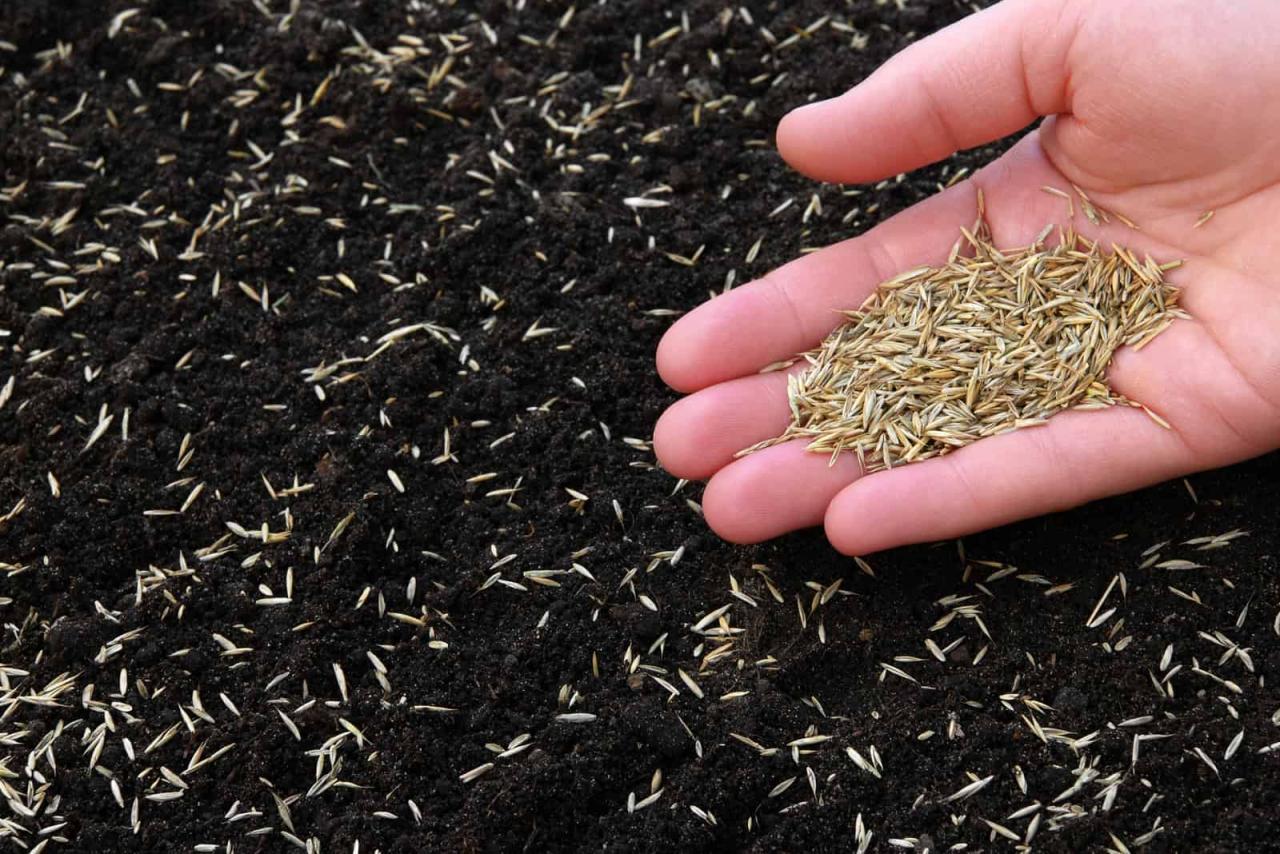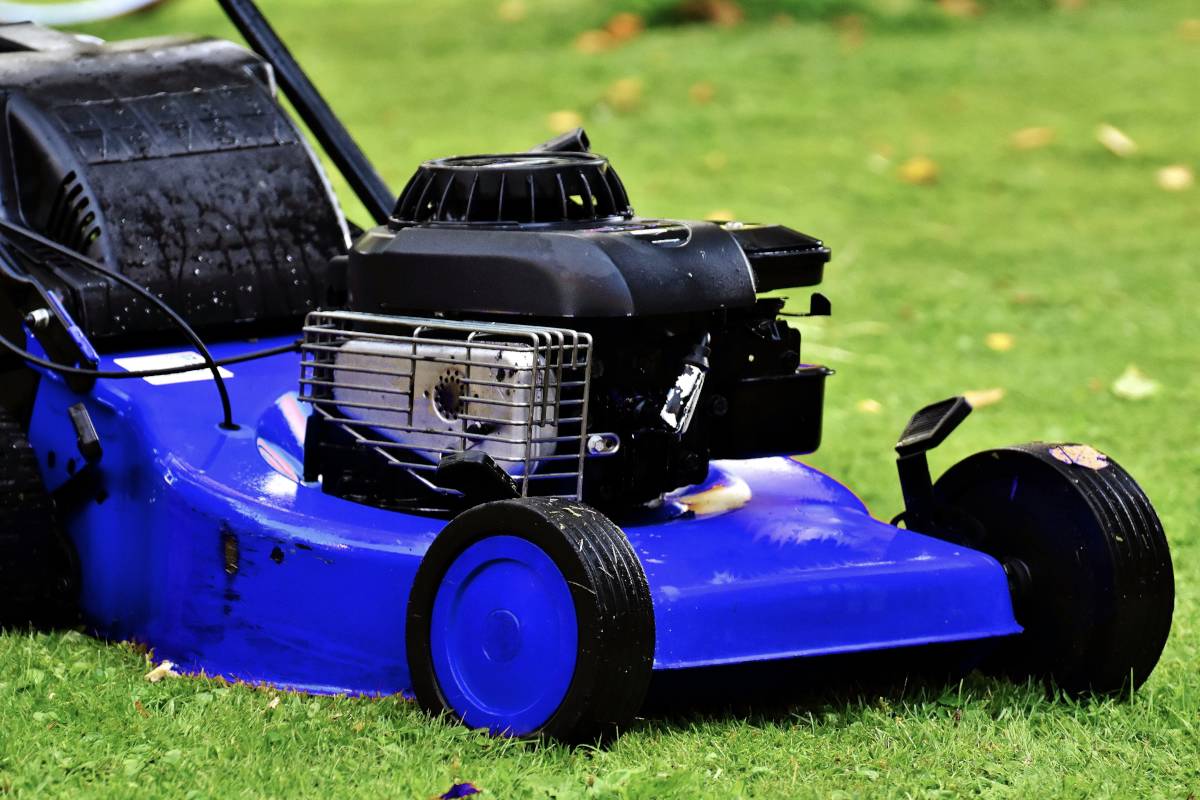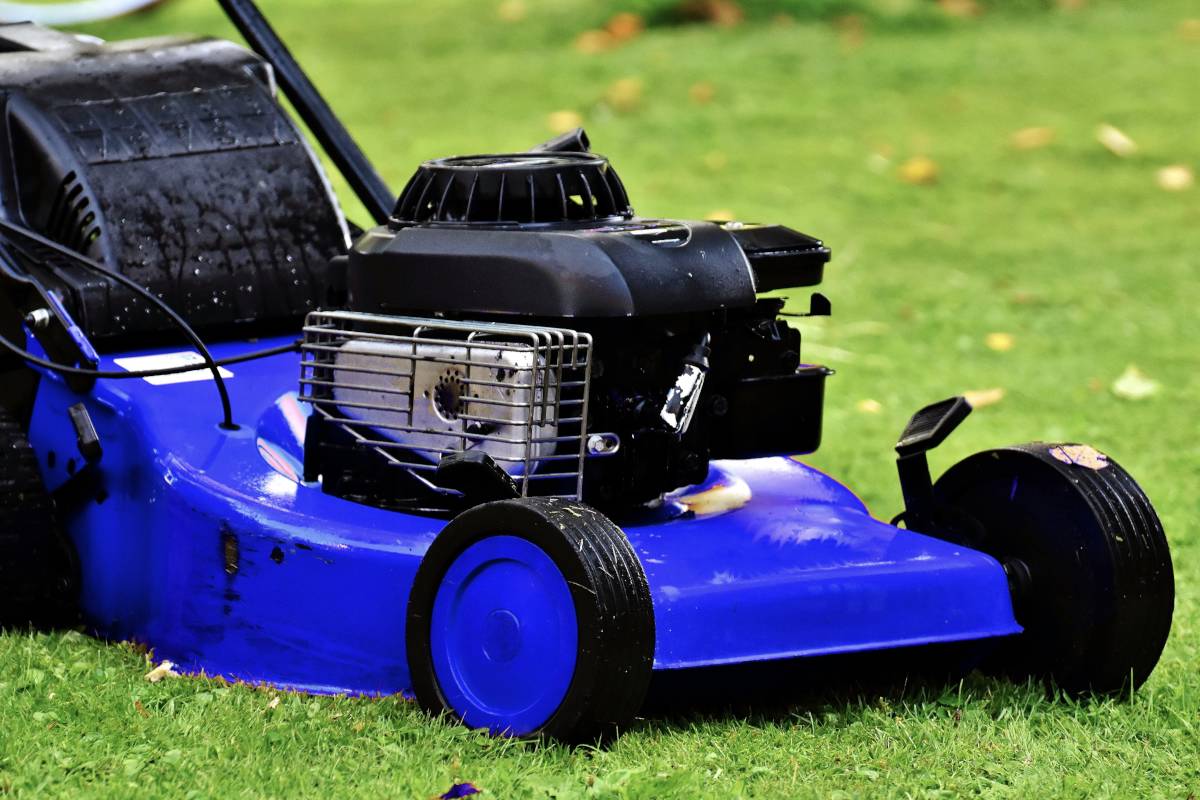How to Achieve a Lush Lawn by Sowing Grass Seed at the Right Time is a fundamental skill for any homeowner seeking a vibrant, healthy lawn. The key to success lies in understanding the nuances of seed selection, soil preparation, and timing.
By choosing the right grass seed variety, preparing the soil properly, and sowing at the optimal time, you can create a lush lawn that will be the envy of your neighborhood.
This comprehensive guide will walk you through each step, from understanding the ideal time for sowing grass seed to maintaining a thriving lawn after germination. We’ll explore the factors that influence the best time for sowing, discuss the importance of soil testing and preparation, and delve into the intricacies of choosing the right grass seed variety.
With this knowledge, you’ll be equipped to create a lush lawn that will flourish for years to come.
Understanding the Ideal Time for Grass Seed Sowing
Sowing grass seed at the right time is crucial for achieving a lush, healthy lawn. The ideal time window varies depending on your climate and the type of grass seed you choose.
Factors Influencing the Best Time for Grass Seed Sowing
The success of your lawn depends on several factors, including:
- Climate:Temperature, rainfall, and humidity all play a role in grass seed germination and establishment. Warmer temperatures and consistent moisture are ideal for seed growth.
- Grass Type:Different grass varieties have different temperature requirements. Cool-season grasses thrive in cooler temperatures, while warm-season grasses prefer warmer conditions.
- Soil Conditions:The soil’s temperature, moisture content, and nutrient levels influence seed germination and root development.
Determining the Ideal Sowing Window for Specific Regions
To determine the best time to sow grass seed in your region, consider the following:
- Cool-Season Grasses:These grasses, such as Kentucky bluegrass, perennial ryegrass, and fine fescue, perform best in cooler temperatures. The ideal sowing window for cool-season grasses is typically in the early fall(late summer to early autumn) or early spring(late winter to early spring).
- Early Fall:This period allows the seeds to germinate and establish roots before the ground freezes, providing a strong foundation for the following spring.
- Early Spring:Sowing in early spring allows the grass to establish itself before the summer heat arrives, providing a lush lawn throughout the growing season.
- Warm-Season Grasses:These grasses, including Bermuda grass, zoysia grass, and St. Augustine grass, thrive in warm temperatures. The ideal sowing window for warm-season grasses is typically in the late spring(May to June) or early summer(June to July).
- Late Spring/Early Summer:These periods offer the warm temperatures and sufficient moisture that warm-season grasses require for successful germination and growth.
Advantages and Disadvantages of Sowing Grass Seed in Spring, Summer, and Fall
Here’s a breakdown of the advantages and disadvantages of sowing grass seed in different seasons:
Season |
Advantages |
Disadvantages |
|---|---|---|
Spring |
|
|
Summer |
|
|
Fall |
|
|
Preparing the Soil for Successful Germination
A well-prepared soil is crucial for successful grass seed germination. Just as a foundation is essential for a sturdy building, fertile and well-structured soil provides the ideal environment for new grass roots to develop and thrive.
Understanding Soil Testing
Soil testing is an invaluable tool for understanding the composition of your soil. It provides crucial information about the pH level, nutrient content, and other factors that influence grass growth.
- pH Level:Grass prefers a slightly acidic soil with a pH range of 6.0 to 7.0. Soil that is too acidic or too alkaline can hinder nutrient absorption and lead to stunted growth.
- Nutrient Content:Soil testing reveals the levels of essential nutrients like nitrogen, phosphorus, and potassium, which are vital for healthy grass development.
Soil testing kits are readily available at garden centers and online. The results typically come with recommendations for amending your soil based on the specific needs identified.
Amending the Soil
Once you understand your soil’s composition, you can begin to amend it to create the ideal environment for grass seed germination.
Timing is crucial when sowing grass seed, as it determines the success of your lush lawn. Just like knowing when to plant your garden vegetables, understanding the ideal time to sow grass seed is essential for optimal growth. If you’re looking for fresh and flavorful additions to your meals, you might want to consider incorporating perilla leaf, a versatile herb with a unique flavor profile.
Perilla Leaf in Your Kitchen: How to Use This Herb for Fresh and Flavorful Meals Once you’ve established your lawn, you can focus on maintaining its health and vibrancy, ensuring a green and inviting space for your family and friends to enjoy.
- Compost:Adding compost to your soil improves its structure, drainage, and nutrient content. Compost acts as a natural fertilizer, enriching the soil with organic matter.
- Fertilizer:Depending on the soil test results, you may need to apply fertilizer to provide essential nutrients. Choose a fertilizer specifically formulated for lawns and follow the application instructions carefully.
- Other Essential Nutrients:In addition to nitrogen, phosphorus, and potassium, other nutrients like iron, magnesium, and calcium are essential for healthy grass growth. If your soil test indicates deficiencies in these nutrients, consider applying a balanced lawn fertilizer or a specific supplement.
Choosing the Right Grass Seed Variety: How To Achieve A Lush Lawn By Sowing Grass Seed At The Right Time
Selecting the right grass seed variety is crucial for a thriving lawn, as different types are suited to various climates, soil conditions, and desired lawn characteristics. The right choice ensures your lawn is resilient, healthy, and aesthetically pleasing.
Types of Grass Seed
Different grass types possess distinct characteristics that make them suitable for specific climates and lawn needs. Choosing the right type is essential for achieving a healthy and vibrant lawn.
- Cool-Season Grasses:Thriving in cooler temperatures, these grasses are best suited for regions with temperate climates and moderate summers. They are typically dormant during the summer months.
- Kentucky Bluegrass:Known for its deep green color, fine texture, and excellent wear tolerance, it is well-suited for high-traffic areas and shady conditions.
- Perennial Ryegrass:This fast-growing grass establishes quickly, making it ideal for overseeding or patching bare spots. It’s also highly tolerant of wear and tear, making it a good choice for lawns with heavy foot traffic.
- Fine Fescue:These grasses are known for their drought tolerance and ability to thrive in shady conditions. They are often used in low-maintenance lawns and are suitable for regions with cool, humid climates.
- Warm-Season Grasses:These grasses thrive in hot, humid climates and are typically dormant during the winter months.
- Bermuda Grass:A popular choice for lawns in the southern United States, Bermuda grass is known for its deep green color, fine texture, and excellent wear tolerance.
It is also highly drought-tolerant.
- Zoysia Grass:Zoysia grass is known for its dense, deep green color and its ability to tolerate high temperatures and drought. It is a slow-growing grass that requires less mowing than other warm-season grasses.
- St. Augustine Grass:This grass is known for its thick, lush growth and its ability to tolerate shade. It is a popular choice for lawns in the southeastern United States.
- Bermuda Grass:A popular choice for lawns in the southern United States, Bermuda grass is known for its deep green color, fine texture, and excellent wear tolerance.
Choosing the Right Grass Seed Variety for Your Lawn
Consider the following factors when selecting the right grass seed variety:
- Climate:The climate in your region will determine the best type of grass seed for your lawn. For example, cool-season grasses are best suited for temperate climates with moderate summers, while warm-season grasses thrive in hot, humid climates.
- Shade Tolerance:If your lawn receives a lot of shade, you’ll need to choose a grass seed variety that is shade-tolerant. Fine fescues and Kentucky bluegrass are known for their ability to tolerate shade.
- Drought Resistance:If you live in a region with limited rainfall, you’ll need to choose a grass seed variety that is drought-resistant. Zoysia and Bermuda grasses are known for their drought tolerance.
- Wear Resistance:If your lawn experiences a lot of foot traffic, you’ll need to choose a grass seed variety that is wear-resistant. Perennial ryegrass and Kentucky bluegrass are known for their excellent wear tolerance.
- Desired Lawn Appearance:Different grass seed varieties have different appearances. Some grasses have a fine texture, while others have a coarser texture. Consider the desired appearance of your lawn when choosing a grass seed variety.
Recommended Grass Seed Varieties
- For a Lush, Green Lawn in a Temperate Climate:A mix of Kentucky bluegrass, perennial ryegrass, and fine fescue is an excellent choice for a lush, green lawn in a temperate climate. This mix provides a blend of desirable characteristics, including excellent wear tolerance, shade tolerance, and drought resistance.
- For a Low-Maintenance Lawn:Fine fescue is a good choice for a low-maintenance lawn. It is known for its drought tolerance and ability to thrive in shady conditions.
- For a Lawn with Heavy Foot Traffic:A mix of perennial ryegrass and Kentucky bluegrass is an excellent choice for a lawn with heavy foot traffic. These grasses are known for their excellent wear tolerance.
- For a Lawn in a Hot, Humid Climate:Bermuda grass, Zoysia grass, or St. Augustine grass are good choices for a lawn in a hot, humid climate. These grasses are known for their ability to tolerate high temperatures and drought.
Sowing the Grass Seed Properly

Sowing grass seed correctly is crucial for achieving a lush and healthy lawn. The right technique ensures that the seeds are planted at the optimal depth, spaced appropriately, and distributed evenly. This maximizes germination rates and promotes strong root development, ultimately contributing to a thriving lawn.
Seed Depth
The ideal seed depth depends on the type of grass seed being used. Most lawn grasses require a depth of 1/4 to 1/2 inch. Planting too shallow can lead to seeds being exposed and drying out, while planting too deep can hinder germination.
A good rule of thumb is to use the “seed depth” guideline provided on the seed packet.
Seed Spacing
Proper seed spacing is essential for healthy grass growth. Crowding can lead to competition for resources, resulting in thin and weak turf. Generally, a rate of 2 to 4 pounds of seed per 1,000 square feet is recommended for most lawns.
However, the specific rate will vary depending on the grass type and the desired density.
Seed Distribution
Even distribution of the grass seed is critical for achieving a uniform lawn. Several methods can be used to sow seed, each with its own advantages and disadvantages.
Broadcasting
Broadcasting is a simple method where seed is scattered evenly over the prepared soil. This is best suited for small areas and can be done by hand or using a seed spreader.
Illustration:Imagine a person standing in a field, holding a handful of grass seed and gently tossing it over the ground, ensuring an even spread.
Overseeding
Overseeding involves scattering seed over an existing lawn. This is often used to thicken thin areas or introduce new grass varieties. Overseeding is typically done in the fall or early spring.
Illustration:Visualize a person walking across a lawn, using a seed spreader to distribute seed evenly over the existing grass. The seed spreader is designed to release a consistent flow of seed as the person walks, ensuring an even distribution.
Seed Spreader
A seed spreader is a tool that helps distribute seed evenly over large areas. It’s essential to choose a spreader that is appropriate for the size of your lawn and the type of seed being used. Seed spreaders come in different models, from manual push spreaders to motorized walk-behind spreaders.
Illustration:Imagine a person using a walk-behind seed spreader. The spreader is equipped with a hopper to hold the seed and a mechanism that releases the seed at a consistent rate as the person walks. The spreader is designed to cover a specific area with each pass, ensuring even distribution of the seed.
Just as the right time of year is crucial for achieving a lush lawn by sowing grass seed, the timing of your culinary additions can make all the difference. A dash of fragrant kaffir lime leaf, for example, can elevate a dish from ordinary to extraordinary.
Transform Your Recipes with Kaffir Lime Leaf: A Flavorful Addition to Any Dish for a unique taste experience, and like a well-timed seed, the flavor will flourish and enhance your creation. So, just as the right time to sow grass seed is essential for a thriving lawn, understanding the ideal moment to add ingredients is key to a delicious culinary outcome.
Watering and Light
After sowing the seed, it’s essential to provide adequate watering and light to promote germination and growth. Water the seed thoroughly after sowing, keeping the soil moist but not soggy. Avoid overwatering, as this can suffocate the seeds. The seeds should be kept moist until they germinate, which usually takes 7 to 14 days.
Once the seeds have germinated, they need sufficient sunlight for healthy growth. Most lawn grasses require at least 4 to 6 hours of sunlight per day. If your lawn is shaded, consider choosing a shade-tolerant grass variety.
Maintaining a Lush Lawn After Sowing
After sowing grass seed, consistent care is crucial for a healthy and vibrant lawn. Regular watering, fertilization, and mowing, alongside weed and pest control, contribute significantly to the success of your new lawn.
Watering Schedule
Watering is critical, especially in the initial stages of growth. The goal is to keep the soil consistently moist but not waterlogged.
- Initial Weeks:Water deeply and frequently, ideally twice a day for the first few weeks. This ensures the seeds have sufficient moisture to germinate and establish roots.
- Establishment Phase:Once the grass has sprouted and reached a height of about 2 inches, reduce watering to once a day. The frequency can be further reduced as the grass matures.
- Mature Lawn:A well-established lawn typically requires watering only during dry spells, aiming for 1 inch of water per week.
Fertilizing the New Lawn
Fertilizers provide essential nutrients for healthy growth.
- Initial Stage:Avoid fertilizing for the first 4-6 weeks after sowing. This allows the grass to establish a strong root system before applying nutrients.
- Post-Establishment:Once the grass is established, apply a starter fertilizer specifically designed for new lawns. This provides a boost of nutrients to encourage rapid growth.
- Regular Maintenance:After the initial fertilization, follow a regular fertilization schedule based on the specific needs of your grass type. Typically, this involves applying fertilizer every 6-8 weeks during the growing season.
Mowing the New Lawn
Mowing is essential for maintaining a healthy and aesthetically pleasing lawn.
- Initial Mowing:Wait until the grass reaches a height of about 3 inches before the first mow. This ensures the roots have sufficient time to develop.
- Mowing Height:Cut the grass to a height of 2-3 inches. Avoid cutting more than one-third of the grass blade at a time.
- Sharp Blades:Use sharp mower blades to ensure a clean cut and minimize stress on the grass. Dull blades can tear the grass, leading to brown tips and disease susceptibility.
Controlling Weeds and Pests, How to Achieve a Lush Lawn by Sowing Grass Seed at the Right Time
Weeds and pests can compete with your grass for nutrients and water, impacting its health and appearance.
- Weed Prevention:Apply a pre-emergent herbicide before the weeds germinate. This helps prevent weeds from establishing in the first place.
- Weed Removal:Hand-pull or use a hoe to remove weeds that have already emerged. Be careful not to damage the young grass while removing weeds.
- Pest Control:Identify and address pest infestations promptly. This might involve using natural pest control methods or applying appropriate pesticides.
Importance of Regular Maintenance
Regular maintenance is crucial for a thriving lawn. It helps prevent disease, encourages healthy growth, and improves the overall appearance of your lawn.
- Disease Prevention:Regular mowing and fertilization, along with proper watering practices, help maintain a healthy lawn that is less susceptible to disease.
- Enhanced Growth:Consistent care provides the necessary nutrients and conditions for optimal growth. A healthy lawn is more resilient to environmental stresses.
- Aesthetic Appeal:A well-maintained lawn enhances the curb appeal of your property and provides a beautiful space for relaxation and enjoyment.
Closure

Achieving a lush lawn through grass seed sowing requires a blend of knowledge, timing, and patience. By following the steps Artikeld in this guide, you can transform your lawn from barren to beautiful. Remember, understanding the ideal time for sowing, preparing the soil properly, and choosing the right grass seed variety are essential components for success.
With consistent care and attention, you’ll enjoy a thriving lawn that will enhance the beauty of your home and provide a lush haven for relaxation and enjoyment.
General Inquiries
What are the best tools for sowing grass seed?
You can use a variety of tools, including a hand-held spreader, a drop spreader, or a broadcast spreader. Choose the tool that best suits your lawn size and needs.
How long does it take for grass seed to germinate?
Germination time can vary depending on the grass type and weather conditions, but typically takes 7 to 14 days.
How often should I water my newly sown lawn?
Keep the soil consistently moist but not waterlogged. Water deeply and less frequently, aiming for 1-2 inches of water per week.
How do I prevent weeds from growing in my new lawn?
Use a pre-emergent herbicide before sowing the seed, and keep the lawn thick and healthy to outcompete weeds.
